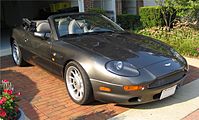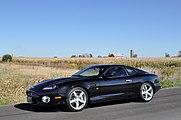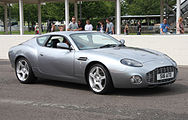Aston Martin DB7
| Aston Martin | |
|---|---|
|
Aston Martin DB7 Coupe (1994-2000)
|
|
| DB7 | |
| Production period: | 1994-2004 |
| Class : | Sports car |
| Body versions : | Coupé , convertible |
| Engines: |
Gasoline engines : 3.2-5.9 liters (250-324 kW) |
| Length: | 4646-4690 mm |
| Width: | 1830 mm |
| Height: | 1270 mm |
| Wheelbase : | 2531-2590 mm |
| Empty weight : | 1754 kg |
| Previous model | Aston Martin DBS |
| successor | Aston Martin DB9 |
The Aston Martin DB7 is a sports car built by the automobile manufacturer Aston Martin from mid-1994 to an unknown date in 2004 . With its 3.2 liter six-cylinder engine, it was the first Aston Martin in twenty years that was not powered by a V8 engine. In addition, with the DB7, Aston Martin's traditional type designation DB was revived, which goes back to the initials of David Brown , the long-time owner of the brand.
A total of over 7000 copies of the DB7 were built.
Model history
The floor pan of the DB7 originally comes from the Jaguar XJS , which in turn inherited it from the Jaguar XJ Mark I , so that the roots of the floor pan go back to the 1960s. Since Jaguar had also been part of the Ford group since 1989, the long-standing brother of the group “was allowed” to serve as a parts supplier. However, it has been fundamentally revised for the Aston Martin and a completely new chassis developed.
The development of the first design prototypes dates back to the 1980s when Jaguar was planning a successor to the Jaguar E-Type and the XJ-S, but the development of the vehicle as the Jaguar Project XJ40 / XJ41 was in a late phase after the sale of Jaguar at Ford at Jaguar several times. During the time when the XJ41 / XJ42 project was being developed, Keith Helfet was head of the Jaguar design department, while Jim Randle was responsible for the vehicle's engineering. At the instigation of the Jaguar motorsport division Tom Walkinshaw Racing, which had been entrusted with the project, the second attempt at the project on the revised Jaguar XJS platform, now called Project XX, was passed on to Aston Martin. Ian Callum , who was previously chief designer at Carrozzeria Ghia in Turin and who had already worked on the design under Jaguar during the development, was commissioned to adapt the project to the Aston Martin design.
The code name during the development of the DB7 was Project NPX , where NPX stood for Newport Pagnell Experimental.
It was formally presented to the public at the Geneva Motor Show in the spring of 1993 and was not drivable due to the lack of an engine and transmission. The DB7 first appeared in the fall of 1994 as a coupé, which was also accompanied by a convertible ( called Volante by Aston Martin ) in November 1995 , the formal public premiere of which took place in 1996 at the LA Auto Show and North American International Auto Show .
Up to the V8 Vantage, the DB7 was the most successful model from Aston Martin. By July 1998, 2000 units of the DB7 had already left the assembly hall in Bloxham. This broke the record that the DB6 had set with 1850 units built between 1965 and 1970.
In March 1999, a facelift including a new 5.9 l V12 engine for the DB7 was presented in Geneva and called the DB7 Vantage . Externally, these vehicles are easy to recognize by the large, round fog lights.
From the beginning of 2000 the DB7 was only offered as the DB7 Vantage , again as a coupé and convertible, with this engine and a slightly modified body.
The 4,000th vehicle had been built by the beginning of 2001; in contrast to most other vehicles built by Aston Martin, its specifications were identical to the previous 3999th, as it was the request of the two specimens, a pair of brothers.
Special models
In 1997 the DB 7 Alfred Dunhill edition appeared. The special edition cost £ 138,000 in Great Britain, which made it the most expensive six-cylinder vehicle on offer at the time. The special model was characterized either as a smoker version with a built-in humidor or as a non-smoking version with a care set. Above this, the model can be recognized by the exterior color (Dunhill Silver), the special wheels and the clock in the center console in the "Alfred Dunhill Millennium Design" as well as aluminum panels in the interior.
On behalf of a British Aston Martin dealer, 24 pieces of the special model “DB7 V12 Vantage Stratstone Jubilee” were produced for Europe in 2002 on the occasion of Elizabeth II's golden jubilee , and 26 more with the same design specification were built for the North American market. All vehicles have a dark blue paint.
From 2002 a more powerful version of the V12 engine in the DB7 GT (with manual transmission, 190 units built) or DB7 GTA (automatic transmission, 102 units built), both of which were only available as a coupé. The formal premiere of the DB7 GT took place at the British International Motor Show 2002 in Birmingham . The DB7 GT has a mesh radiator grille, additional air intakes and a special five-spoke wheel design.
Towards the end of the production period, two limited versions of the DB7 were presented: the DB7 Vantage Zagato , which was formally only shown publicly by Aston Martin at the Pebble Beach Concours d'Elegance 2002 and the Mondial de l'Automobile 2002, and the DB AR1 , of which only 99 copies were made. Andrea Zagato created a new body for both, but technically they largely correspond to the Vantage versions. While the DB AR1 , whose AR1 stands for America Roadster 1, was designed in the style of a classic roadster without a full roof, but otherwise technically largely resembled the DB7 Volante - optionally with the drive train of the DB7 GT - the wheelbase of the Zagato was shortened and the weight significantly reduced in order to achieve an even sportier orientation than the DB7 GT. The wheelbase of the DB AR1 was not shortened as in the DB7 Vantage Zagato, as this would have made a homologation procedure necessary in the USA. The DB AR1 was shown publicly for the first time at the LA Auto Show 2003. Both Zagato models are pure two-seater.
Vehicle characteristics
body
The DB7 was offered as a 2 + 2 Coupé and as a Cabriolet (Volante). The body is a self-supporting steel body with composite fenders. Initially, the bodies were painted at Rolls Royce in Crewe .
drive
For both body variants with a first was Eaton charged -Compressor 3.2-liter six-cylinder gasoline engine provided with a maximum power of 250 kW (340 hp) and 24 valves, based on the AJ6 engine of Jaguar. It was optionally equipped with a synchronized five-speed manual transmission or an electronically controlled four-speed automatic transmission . The top speed is 265 km / h, the sprint from 0 to 100 km / h should be possible in 5.5 seconds.
The V12 engine used in the DB7 Vantage has a maximum output of 313 kW (426 hp). The V12 engine was also used in the GT (maximum output of 324 kW), GTA (maximum output of 313 kW), Zagato (maximum output of 324 kW) and AR1 (maximum output of 313 kW and 324 kW).
In 2012, a vehicle was auctioned that was factory-fitted with a V8 engine.
suspension
The suspension consists of double wishbones with an anti-dive system, coil springs, dampers and a torsion bar at the rear. In addition, the DB7 was equipped with Teves ABS and Bridgestone tires specially developed for it.
Furnishing
Both the Coupé and Cabriolet have double airbags, side impact protection, an on-board computer and a high-quality interior with air conditioning, a stereo system with six loudspeakers, cruise control, Connolly leather upholstery, wool carpets and a center console in walnut wood.
Related vehicles
In 1996 the donor ratio was reversed and the then new Jaguar XK (X100) was developed on the basis of the DB7, but brought onto the market a class lower. The 3.2-liter supercharged engine used in the first few years was also a supercharged AJ6 engine from Jaguar, which was only used by the sister brand until the end of 1993 and was revised there as early as 1994. The rear lights of the DB7 have their origins in the Mazda 323F .
Technical specifications
| model | Engine type | Displacement | Max. power | Max. Torque | Acceleration, 0-100 km / h | Maximum speed, v max | built number |
|---|---|---|---|---|---|---|---|
| DB7 | R6 engine | 3.2 l | 250 kW (340 hp) | 491 Nm | 6.0 s | 250 km / h | 2449 |
| DB7 Volante | |||||||
| DB7 Vantage | V12 engine | 5.9 l | 313 kW (426 hp) | 542 Nm | 5.1 s | 265 km / h | 3682 |
| DB7 Vantage Volante | |||||||
| DB7 GT | 324 kW (441 hp) | 556 Nm | 5.0 s | 298 km / h | 302 | ||
| DB7 GTA | 313 kW (426 hp) | 542 Nm | |||||
| DB7 Zagato | 324 kW (441 hp) | 556 Nm | <5.0 s | 99 | |||
| DB AR1 | 313 kW (426 hp) | 556 Nm | approx. 5.1 s | 100 | |||
| 324 kW (441 hp) | 542 Nm | approx. 5.0 s |
literature
- David Dowsey: Aston Martin: Power, Beauty and Soul . Images Publishing Group, 2010, ISBN 978-1-86470-424-2 , pp. 124–133, 146–159, 186–189, 218–225, 260–267, 272–275 (English, google.com [accessed February 27, 2019]).
- Andrew Noakes: Aston Martin DB7 - The Complete Story. The Crowood Press Ltd., 2006, ISBN 1-86126-823-8 .
Web links
- DB7 / DB7 Volante on astonmartin.com (English)
- DB7 Vantage / DB7 Vantage Volante on astonmartin.com (English)
- DB7 Zagato / DB AR1 on astonmartin.com (English)
Individual evidence
- ↑ Paul Walton: Jaguar XJ41 / 42 is the car did what supposed to replace the XJ-S in the Eighties - Drive. In: drive-my.com. September 7, 2018, accessed February 27, 2019 .
- ↑ Chris Perkins: The Aston Martin DB7 Evolved From a 1980s Jaguar F-Type That Never Happened. In: roadandtrack.com. July 22, 2016. Retrieved February 27, 2019 (American English).
- ↑ a b Aston Martin DB7 1993. In: royalautomobileclub.co.uk. Retrieved February 27, 2019 (UK English).
- ↑ DB7 i6 Prototype Project NPX "Aston Martins.com. In: astonmartins.com. Retrieved February 27, 2019 .
- ↑ a b David Dowsey: Aston Martin: Power, Beauty and Soul . Images Publishing Group, 2010, ISBN 978-1-86470-424-2 , pp. 132 (English, google.com [accessed February 27, 2019]).
- ↑ DB7 V12 Vantage. In: astonmartins.com. Retrieved December 9, 2013 .
- ^ New Records For Aston Martin - The 4000th Aston Martin DB7. In: autointell.com. February 21, 2001, accessed February 27, 2019 .
- ↑ Aston Martin DB 7 "Alfred Dunhill Edition"
- ↑ Aston Martins.com - DB7 i6 Alfred Dunhill
- ^ DB7 Zagato. In: register.amht.org.uk. Retrieved February 27, 2019 .
- ^ DB7 V12 GT «Aston Martins.com. In: astonmartins.com. Retrieved February 27, 2019 .
- ↑ a b Mike Husleag: 2002 - 2003 Aston-Martin DB7 GT | Top speed. In: topspeed.com. October 27, 2005, accessed February 27, 2019 .
- ^ DB7 Zagato. In: register.amht.org.uk. Retrieved February 27, 2019 .
- ↑ Steve Wakefield: DB7 Zagato. In: register.amht.org.uk. November 30, 2012, accessed February 27, 2019 .
- ↑ a b Malte Jürgens: Double test Aston Martin DB7 against Jaguar XK8 Coupé - auto motor und sport. In: auto-motor-und-sport.de. April 2, 1996, accessed February 27, 2019 .
- ↑ Jonathan Bell: Engines of Change: Revealing the Power Behind Sports Cars | The Aston Martin Magazine. In: magazine.astonmartin.com. Retrieved February 27, 2019 .
- ^ Ian Adcock: For Auction: Unique Aston Martin V8 DB7. In: roadandtrack.com. August 17, 2012, Retrieved February 27, 2019 (American English).
- ↑ Which cars share the same lights? | Fast car. In: Fast Car. May 28, 2012. Retrieved January 24, 2018 .








